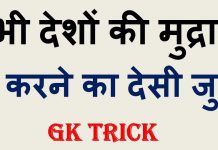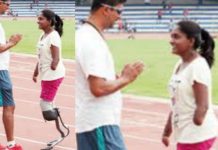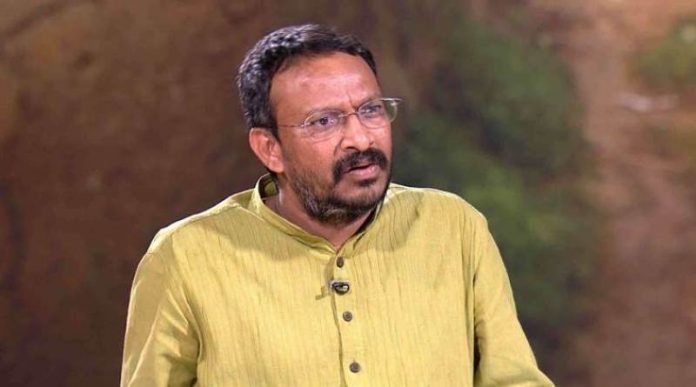National News
More toilets only mean more scavengers, says Bezwada Wilson
The Ramon Magasaysay award has turned the spotlight on manual scavengers again but the shadow of Swacch Bharat looms over them, says one of this year’s awardees, Bezwada Wilson — one of the founders and convener of the Safai Karmachari Andolan, a civil society movement that aims to eradicate manual scavenging.
Many of these toilets will be constructed in areas where sanitation facilities, including septic tanks and running water, are not available. Who will remove the waste there?
There are two lakh manual scavengers in India today, nearly all of them concentrated in North India.
The Safai Karmachari Andolan and its convener firmly believe the perpetuation of caste-based occupations in the country has trapped Dalits in demeaning occupations like manual scavenging.
Safai Karmachari Andolan (SKA)
- It is a civil society movement committed to the total eradication of manual scavenging and the rehabilitation of all scavengers for dignified occupations.
- In 1994, Bezwada helped found Safai Karmachari Andolan (SKA) along with S. R. Sankaran and Paul Diwakar.
- SKA’s goal is to end the practice of manual scavenging and help those engaged in it find dignified work.
- SKA trains teams to work towards the elimination of manual scavenging in various Indian states. SKA initially worked on the state level, until 2003 when Bezwada and four other team members moved to Delhi to launch the Safai Karmachari Andolan nationwide.
Bezwada Wilson
- He is an Indian activist and one of the founders and National Convenor of the Safai Karmachari Andolan (SKA)
- He is well known as one of the leading figures of the Dalit movement in India.
- His work at SKA, a community-driven movement, has been recognized by the Ashoka Foundation which has nominated him a Senior Fellow.
- On July 27, 2016, he was honoured with the Ramon Magsaysay Award
What is Manual Scavenging?
“Manual scavenger” means a person engaged in or employed for manually carrying human excreta and the expression “manual scavenging” shall be construed accordingly.
Statistics
- The practice of manual scavenging, officially banned since decades in India, continues with impunity in several States.
- The latest Socio-Economic Caste Census data reveals that 1, 80, 657 households are engaged in this degrading work for a livelihood.
- Maharashtra, with 63,713, tops the list with the largest number of manual scavenger households, followed by Madhya Pradesh, Uttar Pradesh, Tripura and Karnataka, as per Census data.
Measures taken by the government to end manual scavenging
- In 1908-81, the Ministry of Home Affairs took up the Centrally Sponsored Scheme for Liberation of Scavengers by way of conversion of existing dry latrines into low cost pour flush latrines and providing alternative employment to the unemployed scavengers as one of the measures for removal of Untouchability and providing financial assistance in selected towns.
- A Task Force constituted by the Planning Commission in July 1989 on the subject suggested for separate scheme for liberation and rehabilitation. It also explored the bases for the enactment of certain legislation to ban construction and continuation of dry latrines and prohibit the practice of manual scavenging.
- In 1992, the scheme of ‘Liberation of Scavengers’ was bifurcated.
- For conversion of dry latrines into water borne flush latrines, an ‘Integrated Low Cost Sanitation (ILCS) Scheme, was started.
- The National Scheme for Liberation and Rehabilitation of Scavengers and their Dependents (NSLRS) was started for providing alternative employment to the liberated scavengers and their dependents.
- Taking into consideration the seriousness of the problem and the requests of the State Governments, Parliament enacted the “Employment of Manual Scavengers and Construction of Dry Latrines(Prohibition) Act, 1993”. The Act, inter alia, provides that no person shall:-
- engage in or employ for or permit to be engaged in or employed for any other person for manually carry human excreta; or
- Construct or maintain a dry latrine
- Nevertheless, there were reports of existence of manual scavenging. The Houselisting and Housing Census, 2011 reported that there are about 26 lakh insanitary latrines in the country. Accordingly, the Parliament passed the ‘Prohibition of Employment as Manual Scavengers and their Rehabilitation Act, 2013’ (MS Act, 2013) which came into effect from 6thDecember, 2013
The objectives of 2013 Act
Eliminate the insanitary latrines.
Prohibit:-
- Employment as Manual Scavengers
- Hazardous manual cleaning of sewer and septic tanks.
- Survey of Manual Scavengers and their rehabilitation
Main features of the 2013 Act
- Definitions of manual scavengers and insanitary latrines widened to cover not only dry latrines but other insanitary latrines as well.
- Offences under the Act are cognizable and non-bailable and attract stringent penalties.
- Vigilance/Monitoring Committee at sub-Division, District, State and Central Govt. levels.
- National Commission for Safai Karamcharis (NCSK) would, inter alia, monitor implementation of the Act and enquire into complaints regarding contravention of the provisions of the Act.
- Provision of construction of adequate number of sanitary community latrines in urban areas, within three years from the date of commencement of this Act to eliminate the practice of open defecation.
Constitutional safeguards:
- Article 14: Equality before law. (Right to Equality)
- Article 16 (2): Equality of opportunity in matters of public employment
- Article 19 (1)(g) : Right to Freedom (Protection of certain rights regarding freedom of speech), to practice any profession, or to carry on any occupation, trade or business.
- Article 21 : Protection of life and personal liberty
- Article 23 : Prohibition of traffic in human beings and forced labor.
Special status for Andhra Pradesh: MPs raise slogans
- The Lok Sabha was adjourned twice when members from the Y.S. Rajasekhara Reddy Congress (YSRCP) and Telugu Desam Party raised slogans demanding special status for A.P.
- Finance Minister Arun Jaitley assured them that the government was looking at their demand. “Some members have concerns over particular issues. The Government stands by its commitment. We are trying to find a solution to these issues,” Mr. Jaitley said.
Background
- Andhra Pradesh is asking for Special Category Status not Special Status, there’s a big difference between Special Status and Special Category Status.
- Special Status is guaranteed by the Constitution of India through an Act passed by the two-third majority in both houses of the Parliament (example – J&K)
- Special Category Status(SCS)is granted by the National Development Council, an administrative body of the government.
- Special category status is usually based on the recommendations of the National Development Council (NDC).
What are the parameters?
- Low resource base, hilly & difficult terrain
- Low population density or sizeable share of tribal population
- Backwardness, border states/ sharing the international border
- Economic & infrastructural backwardness
- Non-viable nature of state finances
Which States are receiving it right now?
Assam, Jammu and Kashmir, Nagaland, Arunachal Pradesh, Manipur, Sikkim, Himachal Pradesh, Meghalaya, Tripura, Uttarakhand and Mizoram. (Total 11)
What are the benefits which states get?
- The Planning Commission allocates funds to states through central assistance for state plans. Central assistance can be broadly split into three components
- Normal Central Assistance (NCA)
- Additional Central Assistance (ACA)
- Special Central Assistance (SCA)
- NCA, the main assistance for state plans, is split to favor special category states:the 11 states get 30% of the total assistance while the other states share the remaining 70%.
- The nature of the assistance also varies for special category states;NCA is split into 90% grants and 10% loans for special category states, while the ratio between grants and loans is 30:70 for other states.
- For allocation among special category states, there are no explicit criteria for distribution and funds are allocated on the basis of the state’s plan size and previous plan expenditures.
- Allocation between non special category states is determined by the Gadgil Mukherjee formula which gives weight to population (60%), per capita income (25%), fiscal performance (7.5%) and special problems (7.5%).
- Special category states also receive specific assistance addressing features like hill areas, tribal sub-plans and border areas.
- Beyond additional plan resources, special category states can enjoy concessions in excise and customs duties, income tax rates and corporate tax rates as determined by the government.
Former BSF D-G to head Naga ceasefire monitoring group
Former Director General of BSF D.K. Pathak has been appointed as the new chairman of the Ceasefire Monitoring Group (CMG) that was created in 2001 to formalise a permanent peace accord with Naga groups.
This is the first time that a police officer has been appointed to the post, which has in the past been held by Army officials.
What is the function of Ceasefire Monitoring Group (CMG)?
- Monitor the implementation of the agreed ground rules during the operation of ceasefire with the NSCN (Issac-Muivah), the NSCN (Khole-Kitovi) and the NSCN (Reformation) in Nagaland
- The main task of the CMG chairman is to help in creation of a conducive atmosphere by talking to the stakeholders on the ground that could pave way for a successful political negotiation and bring a final end to the decades-old insurgency problem in the northeastern border state.
Background
- The NSCN (Khaplang) first signed a bilateral ceasefire agreement with the Centre on April 28, 2001, but it split in 2010, into one led by Khole Konyak and Kitovi Zhimomi.
- The NSCN (K) split again in 2015, forcing expelled members Wangtin and P. Tikhak to form the NSCN (R).
- The NSCN (K) unilaterally abrogated the ceasefire on March 27, 2015.
Blow to AAP as HC says L-G is Delhi’s administrative head
- The Delhi High Court held that theLieutenant Governor was its “administrative head” and that it “continues to be a Union Territory.”
- The High Court also set aside the AAP government’s contention that the L-G was supposed to act“only on the aid and advice of the Ministers” even as it declared “illegal”
- the commission of inquiry ordered by the AAP government into theCNG Fitness scam in the transport department
- also the Commission of Inquiry to go into the alleged irregularities in the functioning of the Delhi and District Cricket Association (DDCA).
- A Bench of Chief Justice G. Rohini and Justice Jayant Nath interpreted Article 239 A, 239AA of the Constitution and the provisions of the Government of National Capital Territory of Delhi Act and the Transaction of Business Rules to rule that Delhi continues to be a Union Territory.
Notifications quashed
- “On a reading ofArticle 239 and Article 239AA of the Constitution together with the provisions of the Government of National Capital Territory of Delhi Act, 1991 and the Transaction of Business of the Government of NCT of Delhi Rules, 1993, it becomes manifest that Delhi continues to be a Union Territory even after the Constitution (69th Amendment) Act, 1991 inserting Article 239AA making special provisions with respect to Delhi,” said the Bench.
- The court also quashed several notifications issued by Chief Minister Arvind Kejriwal after returning to power in February 2015, terming them “illegal” as they were issued “without concurrence of the L-G.”
- The Delhi Government’s senior standing counsel Rahul Mehra said they would file a Special Leave Petition against the judgment in the Supreme Court.


















